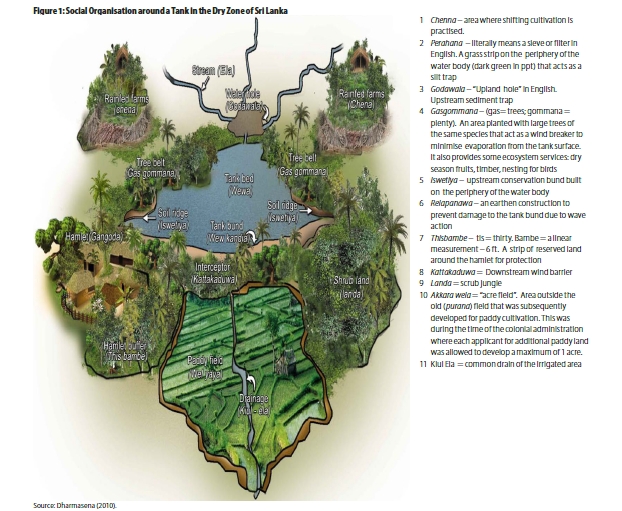Sri Lanka is home to one of the three most famous ancient irrigation civilizations in Asia. The effective functioning of this irrigation system depended on the then social organization as much as on technical accuracy. This paper, first published in the Economic and Political Weekly, explores the changes that are taking place in this social system today and the impact of these changes on the irrigation system.
1. Hydraulic civilization in the dry zone of Sri Lanka
Sri Lanka's irrigation systems depend on cascades of small irrigation tanks. The accompanying illustration from the paper details this irrigation system. Locally managed village tanks for rice irrigation have been in existence in the dry zone of Sri lanka for millennia. The resilience of this system can be explained by the synergy between the tank ecology, social capital, and institutional structures. These tank systems can be said to be a perfect match for the area, because they have in fact been designed for the ecology and society in the region.
Social organization around a tank in Sri Lanka's dry zone (Source: Dhammasena (2010))
2. The tank and its socioecology
This section details the tank irrigation system that irrigates approximately 2,20,000 hectares in Sri Lanka's dry zone. The various components of the tank conserve resources and minimize risk to the system from natural calamities and sedimentation. They were designed for a land use system that included irrigated rice cultivation in the command areas, shifting cultivation in the catchment. and perennial crops in the home garden.
The several interconnections between the tanks ensure that water is subject to use multiple times in each catchment. Tenurial systems enable the proper management of tanks and sharing of tank water, fishing rights etc. Some of these institutions survive today.
3. Fertilizer subsidy and the power of farmer organizations.
The traditional institutions established for irrigation and agriculture management are subject to rapid change today. The centrality of the tank to village society has changed with new lands coming under agriculture, common lands becoming privatized and other market changes. A major change is the fertilizer subsidy started to ensure rice cultivation. Subsidized fertilizers are routed through farmers' organizations. This has led to a surge in the popularity of these farmers' organizations, and to the respect they are accorded in the village.
4. Belated boom in agro-well irrigation
In the 1970s and again around 2000, there was a surge in agro-wells. Vegetables and market crop cultivation on formerly rain-fed lands is now the mainstay of agrarian livelihoods. Increased profits are transforming lives in these villages. These wells have small energy footprints with most using 1 or 2 hp pumps. The high cost of kerosene leads farmers to use groundwater conservatively. However, these wells are rapidly drying up with as many as 30% being out of use.
5. Pump irrigation boom in Mahaweli command
Canal commands are also seeing a surge in pump irrigation. This section details one such boom in Mahaweli command. Here, lift irrigation from the feeder canal has caused a boom in vegetable cultivation.
6. Sri Lanka's unique energy-irrigation nexus
Electricity, though much cheaper than the kerosene option is not cheap in Sri Lanka where farmers pay progressive traiffs. This has led to a demand for energy-efficient irrigation methods, a preference for high-value crops, and some power theft.
7. The Kerala-Sri Lanka model of groundwater irrigation
This section provides a table that outlines four energy-irrigation-livelihoods scenarios in South Asia. It argues that energy subsidies have created a groundwater based agrarian system which place a low value on both electricity and groundwater, to the detriment of energy boards and aquifers. On the other hand, Sri Lanka and Kerala provide a model where high value crops are irrigated through judicious use of groundwater, thus maximizing efficiency.
8. Summary and conclusions
a. The high profits offered by valuable market crops are driving well irrigation, as they offer considerable control over water use. This is not without its drawbacks, which include encroachment, use of chemicals and errosion of social capital.
b. The fertiliser subsidy policy has let do a boom in farmer organizations.
c. CHanges in this policy, allowing open sale of subsidised fertilisers, will weaken the FOs of this authority.
d. SriLanka's electricity tariffs need to recognise farmers agricultural needs as a separate category, similar to Kerala where electricity for irrigation is metered but cheaper than for other uses.
e. Metered irrigation wells can play an important role in load management, since irrigators can be offered incentives to use power in off-peak hours.
Dr. Samad had presented a talk on the same topic during the IWMI-Tata Annual Partners' meet. Watch the video below: